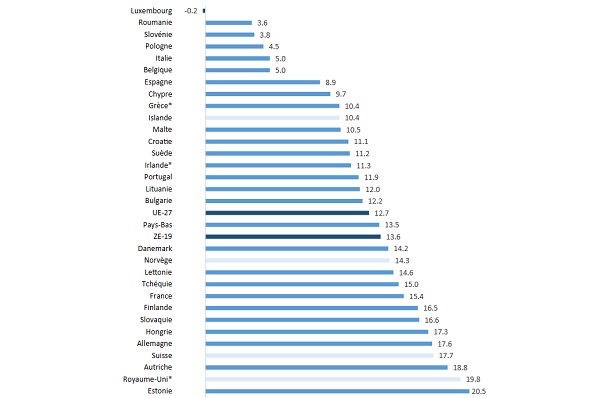
In the lead up to the next International Women's Day on Wednesday 8 March 2023, Luxembourg's national statistics office (STATEC) has published the latest figures on the pay gap between men and women in the Grand Duchy.
While the gender pay gap (GPG) indicator has always been against women in the past, it changed in Luxembourg for the first time in 2021: for the economy as a whole (excluding public administration), the average hourly wage of women was higher than that of men in 2021.
The pay gap indicator calculated by STATEC on the basis of a common European methodology established by Eurostat represents the gap between the average hourly wage of men and that of women, expressed as a % of that of men.
In all other countries of the European Union, this indicator remains positive, i.e. in favour of men. In most countries, it has been decreasing for many years, but remains largely positive in 2021 On the European average, it stands at 12.7% with, for example, 17.6% in Germany, 15.4% in France and 5.0% in Belgium.
To date, Luxembourg is the only EU Member State in which equal pay has been achieved. Still at 10.7% in favour of men in 2006, the GPG has continuously decreased to reach 5.4% in 2014 and 1.4% in 2018.
However, its evolution will probably not stop there. With 0.7% in 2020 and -0.2% in 2021, it is very likely that the pay gap will continue to lean towards women. It is already estimated at -0.4% for 2022. The survey on the structure of salaries for 2022, which will be conducted among companies during the year 2023, will allow a more in-depth analysis on this subject.
Several elements contribute to this particular development of the GPG in Luxembourg:
- the atypical composition of employment in Luxembourg, with a strong component of highly qualified employees working in highly specialised service sectors;
- the average level of education of women is higher than that of men, with an "education gap" which is widening more and more in favour of women in the younger generations (among employees aged between 25 and 35, women already earned 7% more on average than men in 2018);
- the strong presence of women in branches of activity with relatively high salaries (education, health, finance, research, legal services, etc.);
- the favourable positioning of women in middle and higher salary categories, even if they remain under-represented in very high salaries.
According to the report, if a GPG close to 0 is surely a sign of significant progress in terms of equal pay between men and women, we must also see the limits of this indicator:
- this European indicator only takes into account hourly wages, yet the differences between annual wages (including end-of-year bonuses) remain in favour of men;
- the GPG compares average wages and not wages for equal work; it is not adjusted for differences in characteristics or types of positions held by men and women;
- the average level of annual income of all female employees is much lower than that of men due to the fact that the rate of women working part-time is much higher and consequently their number of paid hours is far lower than that of men (the “Gender Hours Gap” is around -13% on average);
- significant gaps remain in many branches taken individually.








